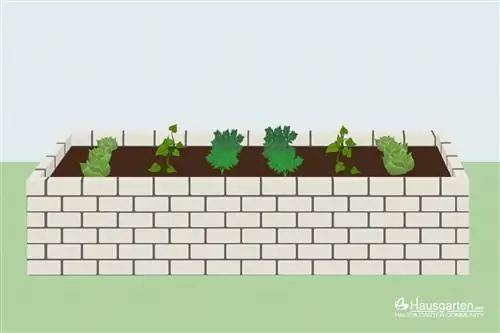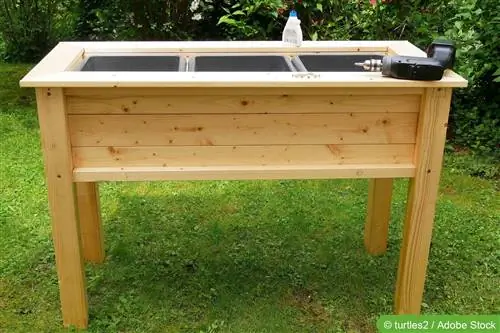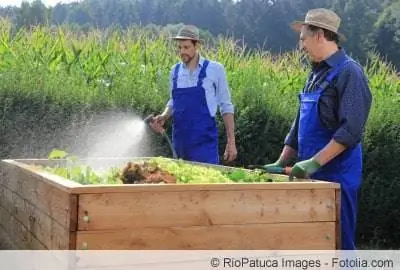- Author admin [email protected].
- Public 2023-12-17 03:39.
- Last modified 2025-01-24 12:45.
A raised bed made of stones looks particularly natural, is durable and can not only increase the yield, but also extend the harvest time. This is how the construction works step by step.
Advantages
Raised beds are more than just a decorative element in the garden. They also bring numerous benefits. These include, among others:
- earlier planting possible
- large amounts of nutrients for a long time
- greater yields
- longer harvest season
- Possible habitat for lizards and other animals
- back-friendly gardening possible
- Protection from snails
- Substrate can be easily customized
- resistant to moisture
Due to the different layers, the temperature in the raised bed can be up to eight degrees Celsius higher than the surrounding soil. This makes it possible to start planting earlier.
In addition, the growth and development of fruits can be prolonged due to the warmth. This significantly increases the yield. This effect is particularly pronounced in raised beds made of stones. Because the stones store the heat of the day and gradually release it overnight.
This also prevents damage caused by late frost, for example. In addition, the raised bed with an appropriate structure can be used as a kind of greenhouse or tomato tent, among other things.
Size and location
The width of the raised bed should be 60 to 70 centimeters if the bed is only accessible from one side. If access is possible from both sides, the width can easily be doubled.
The length depends on the space available and the desired yield. 100 to 120 centimeters are common. However, shorter or significantly longer beds are also possible.
When it comes to orientation, it is optimal to align the long sides to the north and south. This means the short sides face east and west. More important than the position according to the cardinal points are the conditions at the location. For the raised bed made of stones, a sunny place should be chosen that is not shaded by trees, larger plants, buildings or walls. Open areas are therefore ideal.
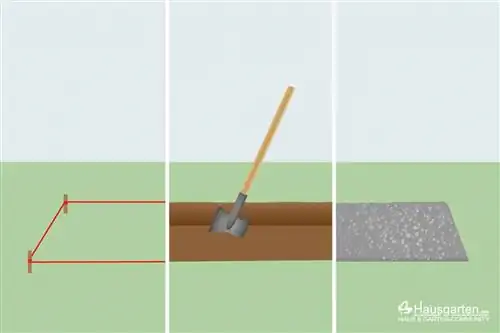
Create foundation
Due to its heavy weight, the raised bed should be built on a foundation. This gives it stability and extends its lifespan.
Requires:
- Concrete
- Drill with stirring attachment
- Bucket
- thread
- coarse gravel
- gravel
- Mini excavator
- vibration plate
- Spade
- stable sticks
- Inch rule
1. Stake out outline
After measuring the outline, it should be marked out for orientation. This is very easy to do using sticks or strips and a thread.
2. Excavate foundation
The struck outline can first be dug out superficially with a spade. a spade depth of around 20 to 30 centimeters is sufficient. The pit can then be dug with a mini excavator to a depth of 60 to 80 centimeters.
3. Compact soil
In order for the foundation to be stable, the floor and walls must be compacted. A vibrating plate is best suited for this. The edges should then be blocked off with boards to form a frame.
4. Fill in gravel and compact
First, a 15 to 20 centimeter thick layer of gravel is filled in and compacted with the vibrating plate. An equally thick layer of gravel is placed on top and also compacted.
5. Pouring concrete
Both concrete and cement can be used to pour the foundation. This provides a stable and resilient base after it dries out. However, this step is not absolutely necessary. A foundation made of crushed stone and gravel can be enough to support the walls of the raised bed. When these preparations are completed, the frame boards can be removed.
Tip:
Both a mini excavator and the vibrating plate can be rented from hardware stores, for example. They make work much easier, which is why their use is particularly useful and recommended when creating several raised beds.

Building a raised bed
Depending on which stones are chosen, the process of building yourself can also differ significantly. In any case, it is important that the stones are securely attached to one another. Mortar can be used as a connecting agent for this purpose.
1. Planning
Planning is crucial, especially with natural stones that have irregular shapes. The stones are initially laid out in a row so that distances and sequences can be planned. This should be repeated for each row.
2. Building walls of the bed
The stones are attached to the foundation with mortar. The rows are then laid out stone by stone and the joints between the individual elements are also connected with mortar. This applies to both the horizontal and vertical directions.
3. Walls
When all the stones are in the correct position, the distances between them should be checked again. Gaps that are too large or deep can be subsequently closed with mortar. This is important to ensure the necessary stability.
4. Filling
The raised bed should only be filled when the walls have completely dried and hardened. Alternatives to natural stone are, for example, bricks or aerated concrete. Due to their shape, they are easier to lay, can be sawn relatively easily to the required size and can also be visually adjusted later. Which stones are suitable for the raised bed depends on several factors.
Tip:
Labeling painter's tape with numbers and sticking it on the individual stones can help you keep your bearings and stick to the order.
Fill raised bed
The substrate in the raised bed made of stones is made up of several different layers. These are:
- 1. Layer: tree cuttings, branches and twigs of shrubs and bushes
- 2. Layer: Grass clippings
- 3. Layer: coarse compost and leaves
- 4. Layer: fine or finished compost and soil
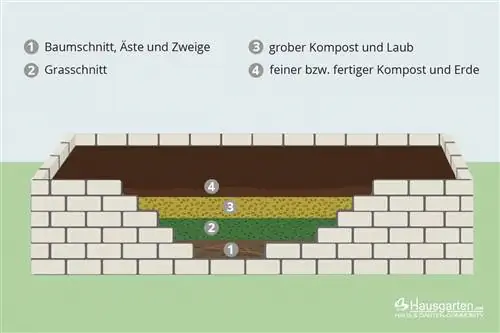
Due to this structure, the rotting times are different, which on the one hand creates heat. On the other hand, the supply of nutrients, insulation from below and drainage of water are ensured.
Planting exterior walls
Especially with natural stone, it is possible to decorate the outer walls of the raised bed with decorative plants. One option for this is houseleeks. They can be used in grooves and improve the look with their striking rosettes. If you don't want to plant directly on the walls, you can also hang pots on them or place them on the upper edge.
Cleaning the stone raised bed
Another advantage of the raised bed made of stone is that it is relatively easy to clean. If moss or other unwanted plants or contaminants accumulate in the joints and irregularities, these can easily be removed with a high-pressure cleaner.
In older raised beds, it may be necessary to repair cracks, large gaps and broken pieces of mortar after cleaning. However, these repairs should only take place once the walls of the bed have been cleaned and are completely dry.

